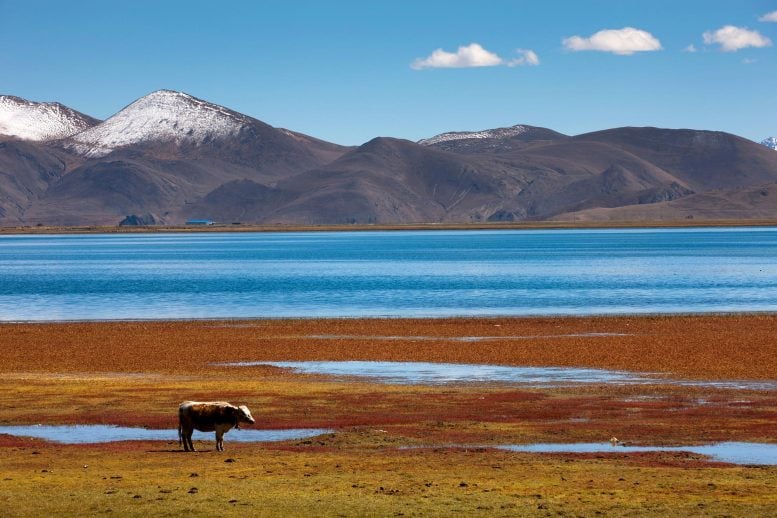
A study predicts significant expansion of Tibetan Plateau lakes by 2100 due to climate change, leading to major land loss and necessitating urgent environmental and economic adaptation strategies.
Increased rainfall and glacier meltwater are set to dramatically reverse the shrinking trend and expand land-locked lakes on the Tibetan Plateau by 50%.
This expansion will result in significant land loss, affecting agriculture, habitats, and infrastructure, and necessitating urgent adaptive strategies to mitigate economic, environmental, and ecological impacts.
Recent reports have stated that more than half the world’s largest lakes, including lakes in the Tibetan plateau, are drying up. However, a paper published today (May 27) in Nature Geoscience suggests that, by the end of this century, land-locked lakes on the Tibetan Plateau are set to increase exponentially, resulting in major land loss and related economic, environmental, and climatic impacts.
Climatic Influence on Lake Expansion
Climate and weather predictions suggest that increased rainfall due to climate change will enlarge these lakes, and see water levels rise by up to 10 meters (~33 feet).
The volume of water caught in these land-locked lakes is estimated to increase fourfold by 2100 according to the research by Dr. Iestyn Woolway of Bangor University (UK) and colleagues in China, Saudi Arabia, USA, and France.
Economic and Environmental Impact
The increased lake surface area will also mean the loss of critical land area, for agriculture, human habitation, critical road and rail networks, and economic disruption.
Dr. Woolway commented, “Climate change is making the Tibetan Plateau greener and more habitable, attracting more people to higher altitudes due to better access to water. However, rising lake levels require urgent planning and policies to mitigate impacts on the region’s ecology and population.”
Ecological and Climatic Ramifications
The resultant land loss could also lead to a change in the landscape, as lakes merge and the course of the rivers which feed and interconnect the lakes are altered.
This could lead to increased greenhouse gas emissions and a positive feedback loop, amplifying climate change. An increase in freshwater, and in flow between lakes could also cause a change in ecology and affect wildlife. As an example, when the Zonang Lake in Hoh Xil Nature Reserve burst its banks in 2011, the Tibetan Antelope found their migration route blocked.
Reference: “Widespread societal and ecological impacts from projected Tibetan Plateau lake expansion” by Fenglin Xu, Guoqing Zhang, R. Iestyn Woolway, Kun Yang, Yoshihide Wada, Jida Wang and Jean-François Crétaux, 27 May 2024, Nature Geoscience.
DOI: 10.1038/s41561-024-01446-w









“Climate and weather predictions suggest that increased rainfall due to climate change will enlarge these lakes, and see water levels rise [exponentially] by up to 10 meters.”
As usual, there is no 95% uncertainty range associated with the upper-bound of 10 meters. It has been my experience that when it comes to precipitation forecasts, on the scale of weather events, the error rate for false-positive forecasts (forecast rain doesn’t happen) is much higher than the error rate for false-negative forecasts (surprise rain). That shouldn’t be too hard to understand. It doesn’t always rain uniformly over a large area; instead, some clouds produce rain and others don’t, and while the clouds are moving with the prevailing wind, precipitation may start and stop, wetting some areas in the path of the cloud while leaving other areas dry. On the other hand, in the absence of clouds, which are easy to see, there is nothing to provide precipitation.
Additionally, clouds and precipitation are the least amenable to prediction by Global Circulation Models (GCMs) because they have to be parameterized (subjectively averaged with best guesses). Different GCMs are known to have diametrically opposite regional predictions for precipitation. While temperature predictions are known to run warm, they are better than precipitation predictions.
Knowing that the weather-forecast precipitation error-rates are not symmetrical, and climate-predictions for any given scenario are problematic, we are expected to believe that climate predictions, for producing exponential increases in precipitation, are believable. Show me the numbers!
“Increased rainfall and glacier meltwater are set to dramatically reverse the shrinking trend and expand land-locked lakes on the Tibetan Plateau by 50%.”
For those who are reluctant to accept such assertions as the above, without supporting empirical measurements, I can recommend reading the following:
https://wattsupwiththat.com/2024/05/27/it-gets-rainier/
I understand that the Himalayan glaciers are melting at relatively very high rates, these Anthropogenic Global Heating days, just as the glacier across which I used to walk to work 50 years ago is now a scenic lake. Dunno about rainfall, but those melting glaciers are going have an interest effect as to how much water flows into lakes, how many rockfalls cause serious avalanches and massive violent debris flows down narrow valleys and how the lives of 2-3 billion people are going to change in all probability courtesy of firearms and mass migration. Presumably some of those melting glaciers have outlets onto the Tibetan Plateau.
The other side of the coin is that during the Little Ice Age, the advancing glaciers in the Alps destroyed villages and pastures. If it were to suddenly turn cold again, there would be less melting at the ‘Roof of the World,’ and those 2-3 billion people you expressed concern about would not have sufficient water. Even if the the climate provided the same amount of water as it currently does, those 2-3 billion people will have water shortage problems in the future if their population continues to grow.
The one thing that does not change is change itself. The world is always changing. Not always for the better.
I should remind you that Alexander The Great conquered all of the known world without the benefit of firearms. With enough people, mountains can be moved even if their only tools are hammers and shovels. Perhaps a case of too much of a good thing.